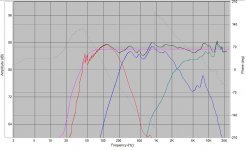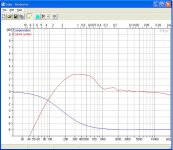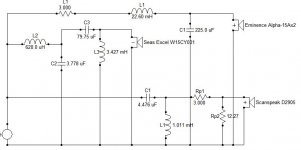I just received lots of speakers in the mail. A pair scanspeak revelators, a pair seas excel drivers and 2 pairs eminence alpha's 15". I'm going to build a something similar to the Jamo R909 using passive crossovers. I think the Jamo design is ingenious, it matches 2 high effeciency 15" woofers with a low effeciency mid and tweeter using a large inductor to correct for open baffle rolloff.
Anyone interested in providing me with guidance (I'll need lots of it) who is willing to conbribute and learn from my mistakes is welcome to join me in this project. 🙂
Anyone interested in providing me with guidance (I'll need lots of it) who is willing to conbribute and learn from my mistakes is welcome to join me in this project. 🙂
dipole
If you go to John Kreskovsky site he has developed a spreadsheet that has the tools you need to design a dipole. You will just need to build some baffles and take some measurements of your drivers in them. If you don't already have a measurement system you can always download Speaker Workshop.
http://www.musicanddesign.com/A_B_C_Dipole.html
If you go to John Kreskovsky site he has developed a spreadsheet that has the tools you need to design a dipole. You will just need to build some baffles and take some measurements of your drivers in them. If you don't already have a measurement system you can always download Speaker Workshop.
http://www.musicanddesign.com/A_B_C_Dipole.html
Here are guidelines for passive OB speakers:
http://www.audiocircle.com/circles/index.php?topic=41297.0
The basic idea: a 6dB lowpass (series inductance) with very low cutoff (high inductance) that shelves the 6dB rolloff, the real cutoff frequency is defined by the baffle width. The drivers must have a good FR in the higher regions because of the 6dB cutoff. The guy at audiocircle used low Qts because his air coils have high resistance and therefore influence the Qts quite a lot. With standard iron coils I would recommend the Hemp 15" OB driver.
The Alphas both have too high Qts and too bad top end for this design.
Greets, Oliver
http://www.audiocircle.com/circles/index.php?topic=41297.0
The basic idea: a 6dB lowpass (series inductance) with very low cutoff (high inductance) that shelves the 6dB rolloff, the real cutoff frequency is defined by the baffle width. The drivers must have a good FR in the higher regions because of the 6dB cutoff. The guy at audiocircle used low Qts because his air coils have high resistance and therefore influence the Qts quite a lot. With standard iron coils I would recommend the Hemp 15" OB driver.
The Alphas both have too high Qts and too bad top end for this design.
Greets, Oliver
MJK uses huge baffles for the Alphas.
The Hawthorne augie works more or less in narrow baffles with conventional x-over.
http://www.audiocircle.com/circles/index.php?topic=44258.0
The Hawthorne augie works more or less in narrow baffles with conventional x-over.
http://www.audiocircle.com/circles/index.php?topic=44258.0
Hi josephpo
Do also post your request over at avforums.co.za. There are some members there experienced in dipole design.
Do also post your request over at avforums.co.za. There are some members there experienced in dipole design.
I have been very busy playing with different crossover designs, modeling them in Speaker Workshop and building them. I currently busy with design no 5. After every design I had to fix inherent flaws but every time with better results. A lesson I learned the hard way is that the choice of the low range drivers is critical to ensure a reasonable efficient speaker, it is possible to trade in a higher bottom end (F0) for efficiency. Admittedly the Alpha's might not be the best choice for this speaker but it was locally available. Unfortunately it is very expensive to ship these large woofers plus not every web retailer is willing to ship to South Africa. I will thus have to work with the limitations of the Alpha's. I'll be posting some pictures and designs once I've got reasonable results.
Hi,
Consider using the Alpha's in a 0.5 way configuration, i.e. the lower
driver has a larger series inductor - may ease crossover design.
You should also add trap filters for the 2.5Khz peak IMO.
🙂/sreten.
Consider using the Alpha's in a 0.5 way configuration, i.e. the lower
driver has a larger series inductor - may ease crossover design.
You should also add trap filters for the 2.5Khz peak IMO.
🙂/sreten.
Here is MJK`s version with the Alphas and 12dB passive x-over:
http://www.quarter-wave.com/General/OB_Design.pdf
http://www.quarter-wave.com/General/OB_Design.pdf
Josephpo,
The Alfa 15s is a good choice for a R909 type baffle. But you could probably not use more than one unit per speaker. You really should read Martin J King's recent paper on a passive OB design referred to by el'Ol above very carefully. There is a lot to learned there.
You should also consider to use his Math Cad model for simulating your own design.
/Erling
The Alfa 15s is a good choice for a R909 type baffle. But you could probably not use more than one unit per speaker. You really should read Martin J King's recent paper on a passive OB design referred to by el'Ol above very carefully. There is a lot to learned there.
You should also consider to use his Math Cad model for simulating your own design.
/Erling
cph2000 said:Here is a link to a danish chap that has done what you are trying to do. Note that he is "cheating" a bit by using a two digital amp approach with a digital xover - very nice! (midrange and tweeter xo is passive)
Credence
I like his choice of bass drivers and tweeters
Interesting link,could you tell (if you can read it better)at what freguency the jx92s is crossed over,thanks.
Crossover between bass and mid is active with 48 dB/octave at 180 Hz. Only the tweeter is passivbly crossed over at 12 dB/octave at about 7 kHz complementing JX92S.
/Erling
/Erling
The guy at audiocircle used low Qts because his air coils have high resistance and therefore influence the Qts quite a lot.
That's a good point! You know you're going to need a big coil. You could use a low Qts pro driver with high midbass sensitivity (where the imedance curve dips to a minimum.) Doubling effective Re with the coil's series resistance will double Qes and cut midbass sensitivity by 6dB. That could work really well for the dipole juggling act.
I managed to make good use of the holidays and have finished a crossover that might just work. I based the modeling on MJK's article and adjusted for baffle response and floor reflection. Attached is a picture of the combined response with crossover at 222 and 2450. The mid/high crossover is a 2 order LR alignment but the low/mid can't really be described as either LR or Butterworth, it's also probable more of a 3 order crossover. I have some concern with the impendance peak of the two Eminence Alpha woofers at Fs 41 Hz and how this will affect the crossover, time will tell if this will be a problem. Overall effeciency is 86 db within +- 2 from the goal function. The graph legend is
black - combined output
red - two Eminence woofers
blue - Seas mid
green - Scanspeak tweeter
pink - goal
Next step is to build the crossover and take the actual measurements.
black - combined output
red - two Eminence woofers
blue - Seas mid
green - Scanspeak tweeter
pink - goal
Next step is to build the crossover and take the actual measurements.
Attachments
Josephpo
I would recommend that you tame the mid's 8kHz peak with a notch filter. If you used the drivers' actual impedance data, you need not worry about the woofers' impedance peak (unless the inductors have significant series resistance).
Is that a SpeakerWorkshop plot? Did you do acoustic measurements?
I would recommend that you tame the mid's 8kHz peak with a notch filter. If you used the drivers' actual impedance data, you need not worry about the woofers' impedance peak (unless the inductors have significant series resistance).
Is that a SpeakerWorkshop plot? Did you do acoustic measurements?
Hi Shaun,
The crossover is based on manufacturer's data adjusted for baffle response using edge and floor reflection from the MJK paper. For this I used FRD consortium's spreadsheet and adjusted each driver's response and calculate phase information. Speaker workshop was used to do the crossover simulation.
I realise that the combined response can be futher smoothed especially the open baffle reversal just after 500 Hz. I don't really want to start tweaking on a simulated crossover, adding complexity to the network. I'll leave this for when I've got actual measurements taken...
I have attached the open baffle effect from edge for interest sake.
The crossover is based on manufacturer's data adjusted for baffle response using edge and floor reflection from the MJK paper. For this I used FRD consortium's spreadsheet and adjusted each driver's response and calculate phase information. Speaker workshop was used to do the crossover simulation.
I realise that the combined response can be futher smoothed especially the open baffle reversal just after 500 Hz. I don't really want to start tweaking on a simulated crossover, adding complexity to the network. I'll leave this for when I've got actual measurements taken...
I have attached the open baffle effect from edge for interest sake.
Attachments
Hi Shaun,
Good idea, I'll play around with a notch and see if it can smooth things a bit at the top.
Another option would be to change the mid/high crossover to a Butterworth or try to get to a 3'rd or 4' order LR crossover to get the mid to roll off quicker. The dip is measured 85 db (5.2 KHZ) while the peak is at 87.76. db (8.2 KHZ), this is within my +- 2 db goal.
Good idea, I'll play around with a notch and see if it can smooth things a bit at the top.
Another option would be to change the mid/high crossover to a Butterworth or try to get to a 3'rd or 4' order LR crossover to get the mid to roll off quicker. The dip is measured 85 db (5.2 KHZ) while the peak is at 87.76. db (8.2 KHZ), this is within my +- 2 db goal.
- Status
- Not open for further replies.
- Home
- Loudspeakers
- Multi-Way
- Jamo R909 Passive Open Baffle Project


